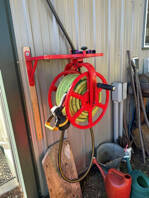Many people select a retirement home so that they can easily age in place. For many avid gardeners, aging successfully in their outdoor space may also be a priority.
As discussed in a previous column (“Accessible gardening,” Sequim Gazette, Aug. 9, page A-6), there are some common-sense tips for accessible gardening: an approach to gardening that enables people with physical and mental challenges to garden.
Last month we covered Tip 1 (keep your garden small and your efforts focused). This article discusses two additional tips:
Tip 2 stresses the need to select a garden site with your specific needs in mind. Choose a site that considers your changing physical limitations. If a suitable site isn’t readily available, consider working with a helper or contractor to develop such a space to help you garden as you age.
Consider these factors:
• Keep your garden near the house with clear access
• Establish ready access to water
• Locate it close and with easy access to tool storage
• Have space for wide paths and entryways (3- to 4-feet wide minimum)
• Terrain should be of minimal slope
• Set aside an area to sit and relax
As always, safety is the number one consideration. The ground should be as flat as possible.
Americans with Disabilities Act (ADA) guidelines suggest any ramps be a maximum of between 5-6 percent (5 percent means that for 1-foot rise there is a 20-foot run). Sloped surfaces are hard for people using wheelchairs and walking aids or for those with low stamina.
Like any garden placement, micro-climate spaces created on your property by trees or buildings can take advantage of wind breaks to create shady or warm spots for resting. Garden smarter by letting nature work for you.
Transporting water is very difficult, as is dragging heavy hoses, so locate the garden as close as possible to a water source. A good hose reel (ideally set in concrete) can assist in winding up hoses. Consider one of the newer collapsible or self-retracting hoses as a light weight and space saving alternative.
If possible, install a drip watering system instead of overhead watering. Drip systems do not have to be elaborate to be effective: soaker hoses left in place that can be easily turned on from a central location are a good option.
Stay healthy
Tip 3 is to garden conscientiously and prevent injuries. Your body is the most important tool you have. As Mark Twain reminds us, “Age is an issue of mind over matter. If you do not mind, it doesn’t matter.” You must take care of yourself, so you can take care of your garden.
These helpful reminders will aid your efforts:
• Warm up and stretch before gardening
• Keep tools in good condition
• Keep hoses and tools tidy to avoid tripping
• Rest frequently, stay hydrated and know your limits
Something as simple as getting up and down to weed can eventually become a challenge.
Retrofitting your garden with solid and stable hand rails or benches, when needed, can help balance your weight while standing. Other small measures to prevent strain and injuries may be found with adaptive apparatus such as a heavy-duty garden kneeler with handles.
If possible, set up a potting bench in your garden space to move much of the work off the ground. Allow for enough work surface so soil, tools, and pots can be available without bending.
Your back may thank you. Anything that makes the work easier and reduces the chance of injury is a good investment.
Accessible gardening Tip 4, that will be discussed in a future column, describes four types of garden structures (raised beds, elevated beds, vertical gardens, and container gardening), which are essential to your effort to prevent injuries.
Looking ahead
Last in the series of articles on accessible gardening will be Tip 5 and Tip 6, which will go into more detail about adaptable tool selection and other support systems.
The Master Gardeners have designed a small Accessible Garden as part of their Woodcock Demonstration Garden at 2711 Woodcock Road and are currently fundraising for its construction.
For more information, an interesting website about the Skagit County Master Gardener’s “Enabling Garden” can be found at skagitmg.org/home/discovery-garden/enabling-garden.
Anna Plager is a Master Gardener of Clallam County who has used accessible gardening practices for many years.


